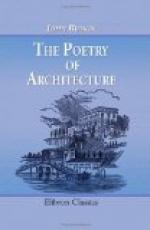[Illustration: Fig. 10. Petrarch’s Villa; Arqua.—1837.]
140. Throughout the whole of this broken country, and, on the summits of these volcanic cones, rise innumerable villas; but they do not offend us, as we should have expected, by their attestation of cheerfulness of life amidst the wrecks left by destructive operation, nor hurt the eye by non-assimilation with the immediate features of the landscape: but they seem to rise prepared and adapted for resistance to, and endurance of, the circumstances of their position; to be inhabited by beings of energy and force sufficient to decree and to carry on a steady struggle with opposing elements, and of taste and feeling sufficient to proportion the form of the walls of men to the clefts in the flanks of the volcano, and to prevent the exultation and the lightness of transitory life from startling, like a mockery, the eternal remains of disguised desolation.
141. We have always considered these circumstances as most remarkable proofs of the perfect dependence of architecture on its situation, and of the utter impossibility of judging of the beauty of any building in the abstract: and we would also lay much stress upon them, as showing with what boldness the designer may introduce into his building, undisguised, such parts as local circumstances render desirable; for there will invariably be something in the nature of that which causes their necessity, which will endow them with beauty.
142. These, then, are the principal features of the Italian villa, modifications of which, of course more or less dignified in size, material or decoration, in proportion to the power and possessions of their proprietor, may be considered as composing every building of that class in Italy. A few remarks on their general effect will enable us to conclude the subject.
143. We have been so long accustomed to see the horizontal lines and simple forms which, as we have observed, still prevail among the Ausonian villas, used with the greatest dexterity, and the noblest effect, in the compositions of Claude, Salvator, and Poussin—and so habituated to consider these compositions as perfect models of the beautiful, as well as the pure in taste—that it is difficult to divest ourselves of prejudice, in the contemplation




